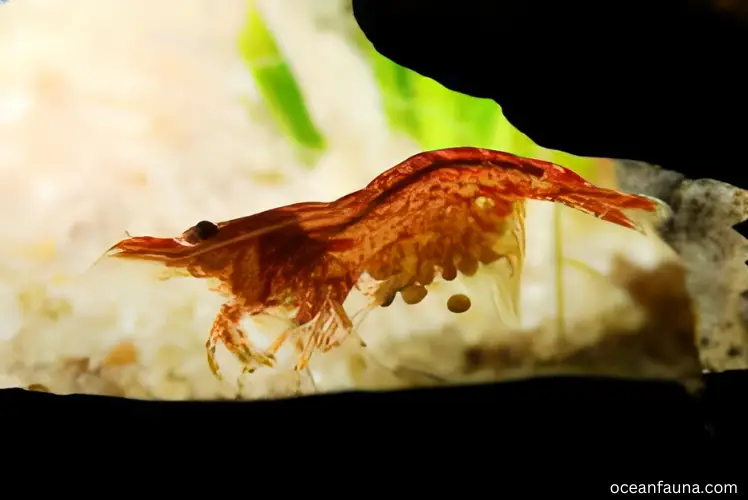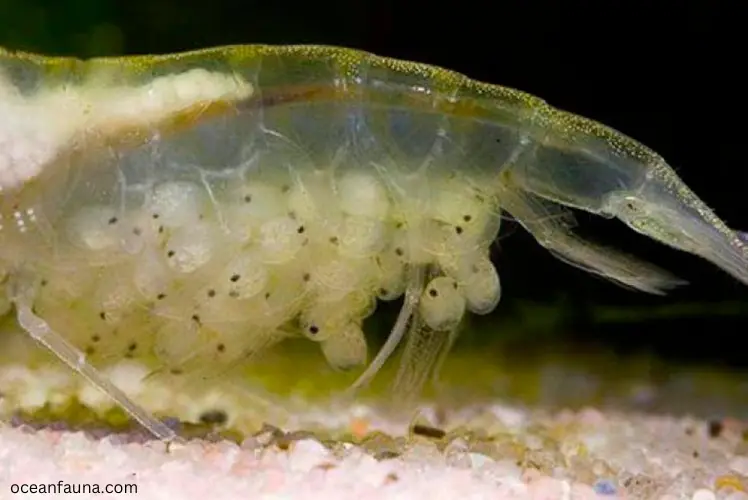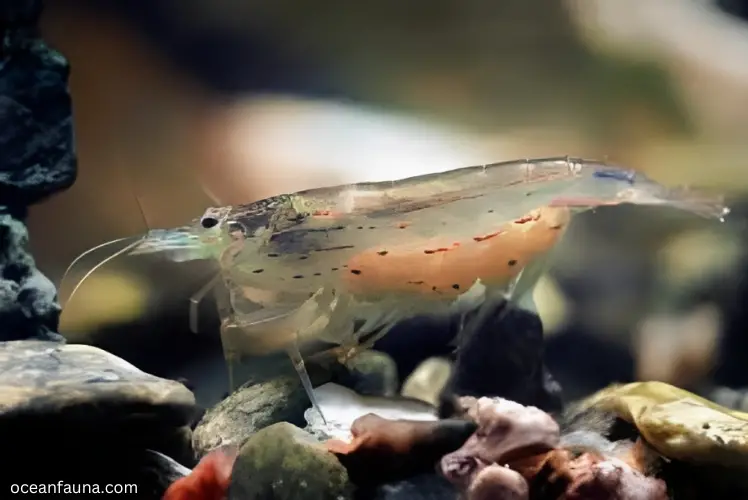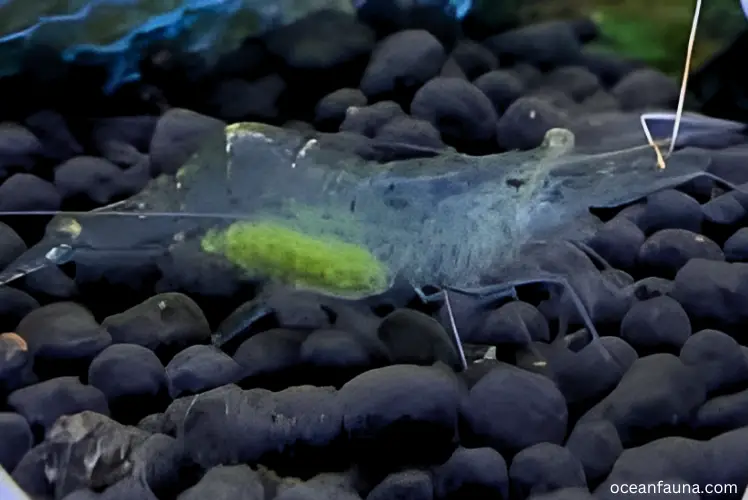To most of us, shrimp is considered a delicious delight. However, some people are more enthusiastic about knowing about shrimp’s anatomy and reproduction procedure other than their taste. And they often ask, do shrimp lay eggs?
Yes, shrimp do lay eggs. Shrimp reproduction varies depending on the species and environmental conditions. Still, the female shrimp generally lays eggs fertilized by the male shrimp. The fertilized eggs are then released into the water and hatch into larvae. The larvae then go through several developmental stages before reaching adulthood.
It is also worth noting that the number of eggs a female shrimp can lay varies greatly between species. Some lay as few as 50 eggs per year, and others lay up to 2 million. The size and quality of the eggs also vary, with larger species generally laying larger eggs.
This guide will cover everything you need to know whether shrimp lay eggs. So sit tight and read to the end as we’ll enlighten you with some great facts about shrimp reproduction!
Reproduction Process of Shrimp
Shrimp are a group of crustaceans that reproduce using sexual reproduction. The reproduction process of shrimp involves several steps, which can be summarized as follows:
Courtship: Male shrimp release pheromones to attract females, and both genders perform a courtship dance to determine if they are compatible for mating.
Mating: The male shrimp transfers sperm to the female shrimp using specialized swimmerets located near the tail. The mating process involves the male transferring spermatophores to the female’s genital opening, where the sperm are released and fertilized.
Fertilization: The sperm fertilizes the eggs inside the female shrimp’s body.
Egg Development: The fertilized eggs are carried in the female’s abdomen, where they develop and hatch into larvae.
Larval Development: After hatching, the larvae are released into the water and undergo several developmental stages before they become juvenile shrimp. Once the shrimp larvae hatch, they are on their own and must fend for themselves. This can be a challenging time for the larvae, as they are small and vulnerable to predators.
The molting hormone is a critical factor in the reproductive process of shrimp. Shrimp molting is controlled by the eyestalk system and the Y-organ through the hormone ß-ecdysone and is essential for shrimp’s growth and development.

Do Shrimp Lay Eggs?
Shrimp lay eggs, but not in the same way that other fish do. Unlike livebearers, such as guppies and mollies, shrimp do not give birth to live young. Instead, female shrimp carry their eggs underneath their body until they hatch. The eggs are carried in a special sac known as the “brood pouch,” which is located on the underside of the shrimp’s abdomen.
The eggs are tiny and almost invisible to the naked eye. In fact, it may be difficult to even see the eggs in the tank as they are usually hidden away in the brood pouch.
In terms of anatomy, male shrimp have a pair of testes and vas deferens, while female shrimp have a pair of ovaries and oviducts. Female shrimp will carry their eggs for several weeks until they hatch, at which point the newly hatched shrimp will emerge from the brood pouch.
There is a common myth that shrimp lay their eggs on the substrate or on the surface of the water. But it’s important to note that shrimp do not lay their eggs on the substrate or on the surface of the water. Instead, the eggs are released deep in the water column, where they provide food for zooplankton and other organisms.
Summarizing everything, shrimp do lay eggs, but they do so in a unique way that sets them apart from other fish. Female shrimp carry their eggs in a brood pouch located on the underside of their abdomen until they hatch.
How Many Eggs Can a Female Shrimp Lay at Once?
There are many different species of saltwater shrimp, and the number of eggs they lay at a time can vary greatly depending on the shrimp species. Some species of shrimp can lay as few as a few dozen eggs at a time, while others can lay several thousand.
On average, most shrimp lay anywhere from 20 to 2,000 eggs at a time. The breeding season for shrimp can also vary depending on the species and environmental factors. Still, many shrimp can begin breeding within 3 to 5 months of maturity.

Here are a few examples of different saltwater shrimp species and their average egg production:
Pacific White Shrimp (Litopenaeus vannamei) – This species is one of the most commonly farmed shrimp in the world. Females can lay anywhere from 100,000 to 500,000 eggs at a time.
Tiger Shrimp (Penaeus monodon) – This species is another popular shrimp for aquaculture. Females can lay up to 1 million eggs per spawn and spawn multiple times per year.
Pandalus borealis – A cold-water shrimp species in the North Atlantic. Females can lay up to 4,000 eggs at a time.
Caridea – This is a large family of shrimp species found in oceans all around the world. The number of eggs they lay can vary widely, from a few hundred to several thousand, depending on the species.
Amano Shrimp – They can lay somewhere between 1000 to 3000 eggs at a time
Tiger Shrimp – The egg-laying number of tiger shrimps are comparatively low, and they lay around 100-300 eggs at a time
Ghost Shrimp – They are often considered to be one of the lesser egg-laying species. They lay around 10-80 eggs
Blue Bolt Shrimp- They lay up to 40 eggs at a time.
Shrimp typically protect their eggs by attaching them to aquatic plants or other objects in the water, where they can be safe from predators until they hatch
In general, larger and older female shrimp are able to lay more eggs than smaller and younger ones. Environmental conditions, such as temperature and water quality, can also affect the number of eggs a female shrimp can lay. Poor environmental conditions can cause stress, which can decrease the number of eggs a female shrimp can produce.
Reproduction in shrimp generally occurs during the summer months, although some species can reproduce year-round.
Shrimp Egg-Laying Process
The shrimp egg-laying process is complex when compared to other animals. But don’t worry; we’re here to help you understand things in the most simplest ways!
The egg-laying process of shrimp starts with the male and female shrimp mating. The sperm from the male shrimp is then stored in a tube between the saddle and the female’s belly. The eggs are present in the female’s saddle until she mates with a male shrimp, and the sperm fertilizes the eggs.
After the eggs are fertilized, they move from the female’s saddle down to the pouch where they are held, which takes about 24 hours. Female shrimp carry their young in the form of eggs, which are carried in the underside of their abdomen.
Shrimp eggs take two to three weeks to hatch. During this time, the female or the mother shrimp takes the responsibility of protecting the eggs. They do everything to keep the eggs away from any danger and dirt and debris.
Once the eggs are ready to hatch, the mother shrimp will release them into the water. They generally don’t release the eggs in the water directly. Rather they release them around plankton or rocks so that the eggs can be safe from other predators.
Shrimp eggs are tiny, almost invisible particles floating in the water column.
In conclusion, the egg-laying process of shrimp is a bit different than other aquatic species. There are several crucial stages involved in the shrimp reproduction process.
How Long Does It Take for Shrimp Eggs to Hatch?
The time it takes for shrimp eggs to hatch varies depending on the species and environmental conditions. There are a few different claims about the hatching period of shrimp eggs.
According to one source, shrimp eggs take two to three weeks to hatch. Another source states that it can take as little as a week or as many as six weeks for brine shrimp eggs to turn into adults. And this time period depends on the conditions or the environment where they live.
For Artemia salina, also known as brine shrimp, the time it takes for eggs to hatch depends on environmental conditions such as temperature, water supply, and salt concentration.

How Are Shrimp Eggs Fertilized?
Shrimp reproduction is typically sexual, with males and females coming together to mate during specific times of the year.
When a female shrimp is ready to lay eggs, she releases them into the water, and the male shrimp releases sperm to fertilize the eggs. The fertilized eggs then develop into shrimp larvae, which eventually hatch and grow into adult shrimp.
In some species of shrimp, the eggs are fertilized internally, with the male shrimp depositing sperm directly into the female’s reproductive system.
However, in most species of shrimp, the eggs are fertilized externally, meaning that the female releases the eggs, and the male then fertilizes them with sperm.
FAQs
Where do female shrimp lay their eggs?
Female shrimp lay their eggs on the underside of their abdomen, typically on the pleopods (swimming legs). The eggs are held in place by a sticky substance that the female secretes, which allows the eggs to remain attached to the pleopods and protected from predators and other environmental factors.
Are the eggs of shrimp fertilized externally or internally?
The eggs of shrimp are fertilized externally, meaning that the female releases the eggs, and the male then fertilizes them with sperm. Shrimp reproduction is typically sexual, with males and females coming together to mate during specific times of the year.
Do shrimp care for their young after they hatch?
No, shrimp do not care for their young after they hatch. Once the eggs hatch, the shrimp larvae are left to fend for themselves. The larvae go through a series of molts and metamorphoses as they grow and develop into juvenile and, eventually, adult shrimp. During this time, they must find food and avoid predators in order to survive.
Do Shrimp Die After Giving Birth?
No, shrimp do not die after giving birth. In fact, female shrimp can carry and release multiple broods of eggs throughout their lives. After the eggs hatch, the larvae are released into the water, and the female shrimp can continue to reproduce.
Can shrimp eggs hatch without mother?
No, shrimp eggs cannot hatch without the mother shrimp. The mother shrimp carries the eggs in a specialized brood chamber located on the underside of her abdomen. The mother shrimp provides the eggs with the necessary nutrients and oxygen for development, as well as protection from predators and environmental stresses.
Conclusion
In conclusion, while there are many different types of shrimp, they do indeed lay eggs when it comes to ocean or saltwater shrimp. These eggs go through various stages of development before hatching into larvae, which then go on to become adult shrimp. Understanding the reproductive habits of these fascinating creatures is just one small part of the vast and complex ecosystem beneath the ocean’s surface.
Furthermore, it’s worth noting that shrimp reproduction has its challenges. Shrimp eggs are often a target for predators. Water temperature, salinity, or pollution changes can significantly impact the health and development of eggs and larvae. These factors can ultimately affect the entire shrimp population and the larger ecosystem in which they exist.
So that’s all. Do shrimp lay eggs? I believe you’ve got your answer! If you have anything more to know, please leave your question in the comment box.


2 thoughts on “Do Shrimp Lay Eggs? [Facts Explained]”